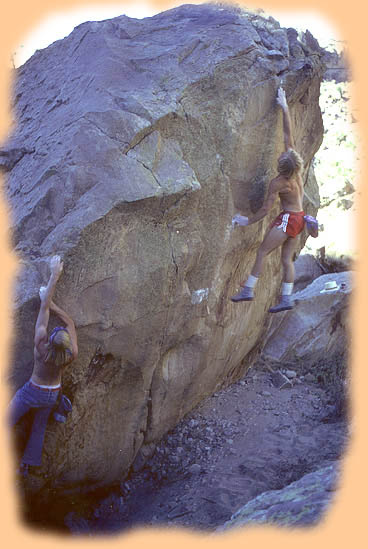| Kinaesthetics
& Dynamics |
 |
|
Reflections
& Commentary: Page 3
|
| Kinaesthetics
& Dynamics |
 |
 John Bachar in Lost Canyon, Pueblo, 1970s |
  Gill Problem - FA 1959  North Overhang - FA 1957 |
Probably
the First V9 . . . This was an entirely new game, and I made up my personal rules as I went along. I did what, in retrospect, seems to have been the first significant dynamic boulder problem in America in 1959 - when I climbed the center of the short, overhanging Red Cross Rock at Jenny Lake in the Tetons. Photos taken in the mid 1960s Done in my original style, the Gill Problem is somewhere around 5.13+ or V9 (at least that's what I'm told. For me, it was merely harder than 5.10 at the time), probably the first anywhere at that level of difficulty. Done statically or dynamically, with an additional, initial obvious right handhold that was altered or "improved" sometime in the 1960s so that it became "usable", it’s easier. So the Gill Route is V6-7. The original problem avoided this initial right handhold. (Several recent magazine articles have confused the ratings). You can see the completion of the dynamic swing here (the problem is not over at this point). Gill Problem, Red Cross Rock - swinging lie-back : Step up into a layback, facing left, into a very difficult hold position, without using the obvious handhold to your right - rotate quickly upwards, reaching small hold over lip with right hand. Continue to top. This problem is not a jump from the ground. (V9) The problem is now considered an artificial eliminate - like a climbing gym route. Alternate normal version: Use the initial right handhold and either move statically or dynamically to the top. (V6-7) Probably the First V8 . . . I had also done a problem almost as hard (V8) on the north side of Red Cross in 1957. This was probably the first boulder problem done anywhere at that level of difficulty: Start from a difficult stance on the rock, under the overhang, feet on a low hold. Pull up on a very small hold and reach, somewhat dynamically, over the overhang. Muscle over the overhang. |
| Dynamic
Techniques . . .
I did free aerial moves where I would spring directly from a set of hand and foot holds partway up an overhanging boulder, disconnect entirely from the rock, and grab onto a much higher hold. Click on photos for larger images. I also did levered springs , either from footholds on the rock, or from the ground itself. These were more than simple jumps. I had developed great strength with my arms extended, pressing down, from the several cross-moves I had mastered on the still rings. So as I would jump I would hold onto some small handhold and press mightily, going much higher and with better control than what could have been done with a simple leap. "Encouraged by Dave Rearick, I decided to seek out John Gill - the undisputed master of dynamic bouldering . . . he did these jumps simply because they were aesthetically pleasing" - Bob Williams in Master of Rock (he criticised my "jumps") The movement I invented and liked the best and which offered more control over my flight, I called a swinging lie-back. Frequently it was reversible, the idea being to latch onto a handhold at the highest point of your arc - if you missed you could possibly rotate back to your starting point (which might be well above ground level), but that took a lot of strength. Years later such a high-point strategy, whether through a swing or not, became known as deadpointing , and was perfected and popularized by the late and great Wolfgang Gullich. Here are several photos of general bouldering dynamics. From 1977: a youthful John Long at his most dynamic , Long -observed by Michael Kennedy-on one of my dynos , a bouldering party with-from left to right-W. Banks, J. Bachar, S. Cheney, J. Long, unknown. "I learned a lot that day about dynamic moves, about doing them smoothly and in control. I was very interested in learning and in pushing my own limits. Now that I had seen this dynamic style done so flawlessly by John, I was hooked" - Jim Holloway in Master of Rock. |
 Fatted Calf - free aerial, 1975  Pennyrile Forest - levered spring, 1965 |